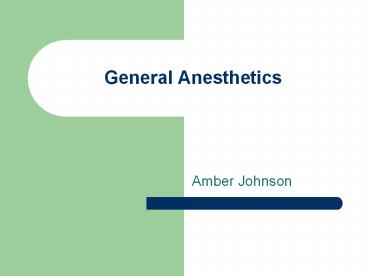General%20Anesthetics PowerPoint PPT Presentation
Title: General%20Anesthetics
1
General Anesthetics
- Amber Johnson
2
What are General Anesthetics?
- A drug that brings about a reversible loss of
consciousness. - These drugs are generally administered by an
anesthesiologist in order to induce or maintain
general anesthesia to facilitate surgery.
3
Background
- General anesthesia was absent until the
mid-1800s - William Morton administered ether to a patient
having a neck tumor removed at the Massachusetts
General Hospital, Boston, in October 1846. - The discovery of the diethyl ether as general
anesthesia was the result of a search for means
of eliminating a patients pain perception and
responses to painful stimuli.
(CH3CH2)2O
4
Anesthetics divide into 2 classes
- Inhalation Anesthetics
- Gasses or Vapors
- Usually Halogenated
- Intravenous Anesthetics
- Injections
- Anesthetics or induction agents
5
Inhaled Anesthetics
- Halothane
- Enflurane
- Isoflurane
- Desflurane
Halogenated compounds Contain Fluorine and/or
bromide Simple, small molecules
6
Physical and Chemical Properties of Inhaled
Anesthetics
- Although halogenations of hydrocarbons and ethers
increase anesthetic potency, it also increase the
potential for inducing cardiac arrhythmias in the
following order FltClltBr.1 - Ethers that have an asymmetric halogenated carbon
tend to be good anesthetics (such as Enflurane). - Halogenated methyl ethyl ethers (Enflurane and
Isoflurane) are more stable, are more potent, and
have better clinical profile than halogenated
diethyl ethers. - fluorination decrease flammibity and increase
stability of adjacent halogenated carbons. - Complete halogenations of alkane and ethers or
full halogenations of end methyl groups decrease
potency and enhances convulsant activity.
Flurorthyl (CF3CH2OCH2CF3) is a potent
convulsant, with a median effective dose (ED50)
for convulsions in mice of 0.00122 atm. - The presence of double bonds tends to increase
chemical reactivity and toxicity.
7
Overview
8
Intravenous Anesthetics
- Used in combination with Inhaled anesthetics to
- Supplement general anesthesia
- Maintain general anesthesia
- Provide sedation
- Control blood pressure
- Protect the brain
9
Essential Components of Anesthesia
- Analgesia- perception of pain eliminated
- Hypnosis- unconsciousness
- Depression of spinal motor reflexes
- Muscle relation
- These terms together emphasize the role of
immobility and of insensibility!
10
Hypotheses of General Anesthesia
- Lipid Theory based on the fact that anesthetic
action is correlated with the oil/gas
coefficients. - The higher the solubility of anesthetics is in
oil, the greater is the anesthetic potency. - Meyer and Overton Correlations
- Irrelevant
- 2. Protein (Receptor) Theory based on the fact
that anesthetic potency is correlated with the
ability of anesthetics to inhibit enzymes
activity of a pure, soluble protein. Also,
attempts to explain the GABAA receptor is a
potential target of anesthetics acton.
11
Other Theories included
- Binding theory
- Anesthetics bind to hydrophobic portion of the
ion channel
12
Mechanism of Action
- UNKNOWN!!
- Most Recent Studies
- General Anesthetics acts on the CNS by modifying
the electrical activity of neurons at a molecular
level by modifying functions of ION CHANNELS. - This may occur by anesthetic molecules binding
directly to ion channels or by their disrupting
the functions of molecules that maintain ion
channels.
13
Cont on Mechanism
- Scientists have cloned forms of receptors in the
past decades, adding greatly to knowledge of the
proteins involved in neuronal excitability. These
include - Voltage-gated ion channels, such as sodium,
potassium, and calcium channels - Ligand-gated ion channel superfamily and
- G protein-coupled receptors superfamily.
14
Anesthetic Suppression of Physiological Response
to Surgery
15
Pharmacokinetics of Inhaled Anesthetics
- Amount that reaches the brain
- Indicated by oilgas ratio (lipid solubility)
- Partial Pressure of anesthetics
- 5 anesthetics 38 mmHg
- Solubility of gas into blood
- The lower the bloodgas ratio, the more
anesthetics will arrive at the brain - Cardiac Output
- Increased CO greater Induction time
16
Pathway for General Anesthetics
17
Variables that Control Partial Pressure in Brain
- Direct Physician's Control
- Solubility of agent
- Concentration of agent in inspired by air
- Magnitude of alveolar ventilation
- Indirect Physicians Control
- Pulmonary blood flow-function of CO
- Arteriovenous concentration gradient
18
Rate of Entry into the Brain Influence of Blood
and Lipid Solubility
19
MAC
- A measure of potency
- 1MAC is the concentration necessary to prevent
responding in 50 of population. - Values of MAC are additive
- Avoid cardiovascular depressive concentration of
potent agents.
20
Increase in Anesthetic Partial Pressure in Blood
is Related to its Solubility
21
General Actions of Inhaled Anesthetics
- Respiration
- Depressed respiration and response to CO2
- Kidney
- Depression of renal blood flow and urine output
- Muscle
- High enough concentrations will relax skeletal
muscle
22
Cont
- Cardiovascular System
- Generalized reduction in arterial pressure and
peripheral vascular resistance. Isoflurane
maintains CO and coronary function better than
other agents - Central Nervous System
- Increased cerebral blood flow and decreased
cerebral metabolism
23
Toxicity and Side Effects
- Depression of respiratory drive
- Decreased CO2 drive (medullary chemoreceptors),
Takes MORE CO2 to stimulate respiration - Depressed cardiovascular drive
- Gaseous space enlargement by NO
- Fluoride-ion toxicity from methoxyflurane
- Metabolized in liver release of Fluoride ions
- Decreased renal function allows fluoride to
accumulate nephrotoxicity
24
Toxicity and Side Effects
- Malignant hyperthermia
- Rapidly cool the individual and administer
Dantrolene to block S.R. release of Calcium

